Burgundy violets
Violet with blue flowers is the progenitor of all subsequent generations. Breeders are constantly working on the development of new colors of Saintpaulias. The most difficult ones are green and yellow.
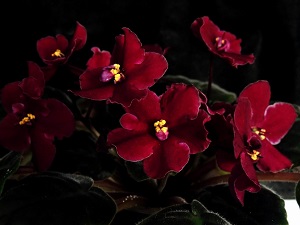 Burgundy violets are very popular. They can be monochromatic or consist of 2 or more colors. Chimeras, violets with prints are appreciated.
Burgundy violets are very popular. They can be monochromatic or consist of 2 or more colors. Chimeras, violets with prints are appreciated.
In appearance, burgundy violets have one of the following forms:
- pansies;
- stars;
- bells;
- bowls;
- wasps.
By terry, there are:
- simple;
- scallop;
- semi-double;
- terry;
- in the form of carnations.

Classification by the degree of doubleness of the flower.
Border and fringe serve as decoration of burgundy violets.
Important! Thanks to the variety of shapes and colors, everyone can find their own unique Saintpaulia.
With prints by flower
Below you will see a photo of burgundy violets with spots and splashes of various flowers on the petals.
Glimmar
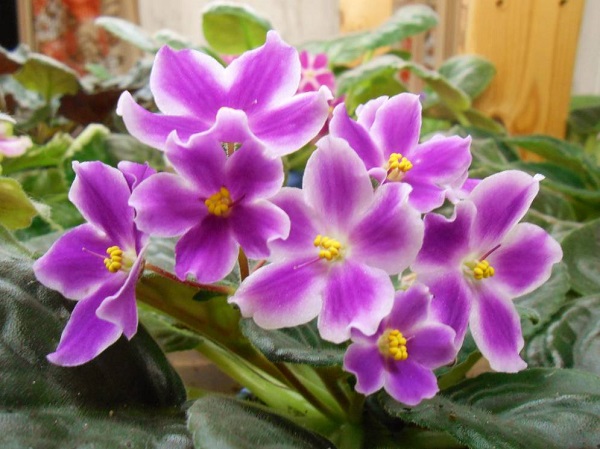
The author of the delicate fragile Saintpaulia is Kent Stork, a breeder from the city of Fremont (Nebraska, USA).
The variety does not cause problems in care and maintenance. Dislikes changing lighting and temperature.
Flowers - in the form of simple stars, the color of the petals - fuchsia-red fingers on a light background. Blooms powerfully. Peduncles are strong enough.
The leaves are dark green. The outlet is large, flat, nice, standard.
RM-Amalia

The owner of this beauty is Natalya Skornyakova, a breeder from Kursk. RM-Amalia grows easily, blooms quickly.
Flowers - in the form of simple large stars (up to 7.5 cm). Petals with a wavy structure, white with bright cherry prints. It blooms very effectively and profusely. It blooms with a beautiful hat. The color appears most vividly at high temperatures.
The leaves are green. The socket is standard, flat.
EC-Shanghai Rose
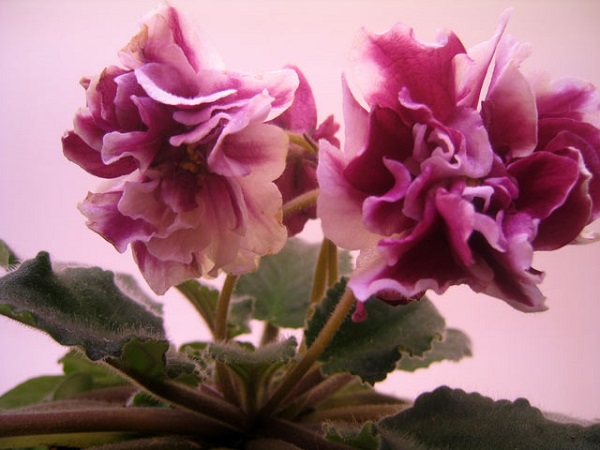
The author of an unusually beautiful variety is Elena Korshunova. This is a sport from the EK-Gardens of Semiramis variety.
The flowers of the Shanghai rose are similar to a rose - huge, airy, dense double structure. The color is not too bright, dark red. The petals are decorated with a wide white border. Peduncles are strong, slightly drooping, but withstand flowers well.
They love light very much. Better to use wick watering.
Leaves are green, pointed. The rosette is neat, for exhibition purposes. Easily stepsons.
RS-Duchess
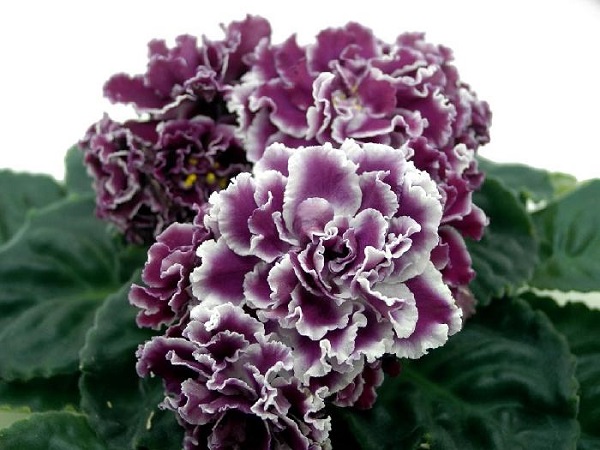
The author of the gorgeous lady is Svetlana Repkina (Lugansk). The variety is hardworking, blooms profusely. It tolerates heat well.
In the first bloom, it may not meet your expectations, stay patient - everything has its time. Can go into sports.
Flowers - luxurious, very large semi-double and double, color - white with plum prints. The petals are corrugated, airy. A lush, beautiful bouquet is formed from the balls.
The leaves are quilted, the color is medium green, quilted. Socket standard.
Bordered
This section presents the names of burgundy violets with a white border.
Powder Keg

The author of the graceful violet is breeder Paul Sorano. It grows slowly. Blooms for a long time.
The flowers are rather large stars, semi-double or double, the color is bright dark red with a white border. Wavy petals. At the first flowering, low peduncles, at the second they become longer.
In low light, the color becomes darker.
The leaves are dark green, red on the back. Rosette up to 45 cm, large standard.
Red lantern
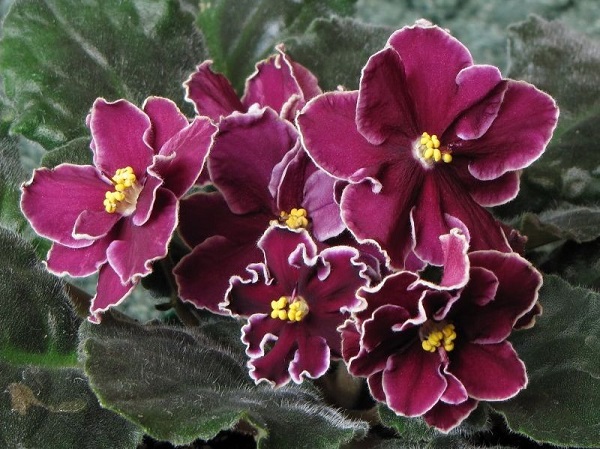
The author of the Red Lantern variety or the Red Lantern breeder Paul Sorano. It shows varietal characteristics well, it is unpretentious in care, it multiplies easily.
Flowers - beautiful, semi-double, velvet stars, color - rich dark red, may have a slightly noticeable pearlescent hue, white border. This dark burgundy violet blooms for a long time.
The leaves are dense, dark green, red on the back. Great standard.
Emergency

The author of this elegant variety is Kent Stork (Kent Stork), a breeder from the city of Fremont (Nebraska, USA).
Flowers - semi-double pansies, color - bright red. On the petals there is a white clear border. Peduncles are slightly long. It blooms profusely.
The leaves are bright, dark green.The socket is standard. It happens, picks up the leaves.
Attention! It does not require special care. Loves natural light, becomes more terry in bright light.
Arcturus

The author of this bright variety is breeder J. Eyerdom. Flowers are similar to Emergency, but lighter, more luxuriant and abundant. It multiplies easily. Loves light.
Flowers - semi-double, dark red with a white border. Wavy petals.
Leaves are ordinary, dark green, juicy, and may have a yellow tint. Socket standard.
Reproduction of violets at home: 2 ways
Basically, Saintpaulias are bred with leaves, segments from plates, rosettes. And although this can be done all year round, experts say that it is still better to propagate the plant in spring or summer. This is due to the fact that during this period there is more heat and light, which are necessary factors for the rapid rooting of planting material.
Leaf
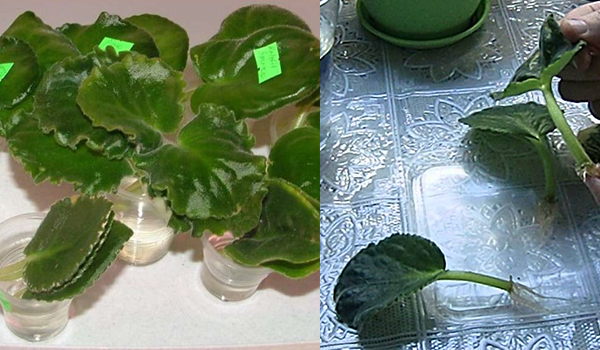
Leaf propagation is the easiest method. Cut the plate under the peduncle from an absolutely healthy plant. The cut needs to be dried for about half an hour. Fill a small dark glass jar (you can use a pharmacy bottle) with cool boiled water with activated carbon powder.
Cover the top with foil, cut a hole and stick a leaf into it. When roots appear, move to soil. A greenhouse is easy to make from a plastic bottle. Babies will appear in a couple of weeks. You need to wait until the leaves in diameter reach 1 cm and plant them in pots.
By dividing
In pots with violets, several leaf rosettes are often formed at once. They are separated by a well-sharp knife. At least a small spine remains on each part. Delenki are immediately planted in the ground.
This video shows the transplantation of children of the Uzambara violet (Saintpaulia).
Care features
The nuances of the conditions of detention
There are no special conditions for growing the bulk of large-flowered violets. The main and most important requirements apply to:
- the size of the pot;
- the quality and composition of the soil;
- lighting;
- temperature;
- the choice of dressings;
- compliance with the irrigation regime.
Only some species prefer a slight decrease in temperature for a richer flower color or bud formation.
How to water properly?
One of the main components of the successful cultivation of large-flowered species of Saintpaulia is the observance of the correct watering regime.
Like almost all types of violets, large-flowered are afraid of drying out and waterlogging of the soil. Therefore, do not overdo it with watering.
Do not pour or overdry the violet.
Advice! It is better to irrigate through the pallet or in small portions through the top along the edge of the container, without falling on the flowers or buds.
The frequency and volume of watering is performed depending on several factors:
- season;
- age condition;
- the size of the container in relation to the size of the plant;
- temperature and humidity in the growing room;
- the amount and saturation of lighting;
- the quality and composition of the soil.
On average, according to the recommendations of experienced flower growers, watering is performed:
- 2-3 times a week in the summer;
- once a week in winter.
Do not forget about the quality of water for irrigation. It should be clean, soft and warm.
Lighting
Daylight hours should be about 12 hours per day. But at the same time, direct sunlight should be avoided on the plant, and diffused light should be provided.
If it is impossible to provide the flower with so much daylight hours, it is better to use additional light sources, which are phytolamps.
Illumination of violets.
Important! Do not forget about the rest of the plant. You should not increase daylight hours for more than 14 hours.
The nature of the feeding
Additional nutrition depends on the growing season and the structure of the leaf plates. At each phase of the growing season, a certain composition of fertilizers should be applied.For large-flowered specimens, additional nutrition takes a special place.
For the full flowering of flowers of this size, you should timely apply the necessary fertilizers, both organic and mineral, containing a full set of necessary micro- and macroelements.
The soil of a newly transplanted violet is depleted after about a couple of months after transplanting. From this point on, the whole complex of substances necessary for the plant should be introduced for the full development, growth and flowering.
In addition to the complex of basic elements - nitrogen, phosphorus and potassium in the ratio NPK: 20:20:20, the composition should also include trace elements: Ca, Fe, Mg, Mo, B, Na, Cu, Z and S.
The first nutrition is applied in the spring after the plant wakes up. During this period, complexes with a high nitrogen content are used.
In the phase of budding and rosette formation, fertilizer complexes with a predominance of potassium and phosphorus are needed.
Subsequent feeding is carried out with fertilizers for violets with an equal ratio of micro- and macroelements.
Reproduction
For large-flowered garden violet feeds, propagation or reproduction of new planting material is carried out by seeds, cuttings or dividing the bush.
Reproduction of room violets (Saintpaulia) is mainly carried out by leaf cuttings, rooting them in water or a substrate, followed by planting the children.
Reproduction by cuttings step by step.
There are varieties that reproduce very well, and there are those with which you need to tinker, providing quality with quantity and creating the necessary conditions. But, in general, large-flowered species reproduce in the same way as ordinary standard specimens.
Care and cultivation of violets at home
It is believed that Saintpaulia is quite demanding to care for. In fact, to ensure abundant flowering, you just need to adjust the watering regime, top dressing, and choose the right nutrient substrate.
Temperature regime
The most comfortable temperature for breeding homemade Saintpaulias is considered to be the range from +18 to +25 ° С. When the thermometer is above or below the indicated norms, the flower will begin to fade, shedding leaves.
Plants are not recommended to be placed in bright sunlight - delicate leaves can get burned. In summer, you should choose windows facing north for violets, in winter - south.
Advice! If it is not possible to move the flowers from the sunny side, you should shade the violet. For this, blinds dosing the intensity of illumination, window foil, newspapers can be used.
Soil for violets
Although the houseplant prefers nutritious soils, it is not recommended to plant flowers in black soil. The best option would be light peaty substrates. Loose soil allows moisture to pass through itself well, does not allow liquid stagnation.
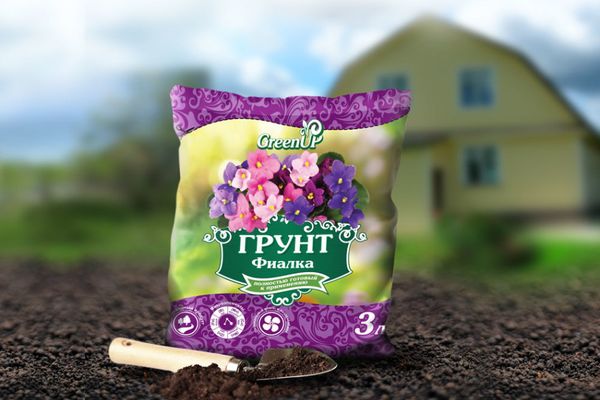
There are several valid options:
- A mixture of 4 liters of peat, 4 liters of vermiculite, 1 tbsp. dry mineral fertilizer, 1 tbsp. dolomite flour.
- A mixture of equal parts of leafy soil, garden soil, sand, sphagnum moss.
- Peat mixed with turf, humus, sand, sphagnum moss. All components must be mixed in equal proportions.
Flower shops offer ready-made soil mixtures for violets. You can mix the soil yourself according to one of the recipes given.
Watering
The greatest amount of moisture is necessary for violets in summer, during the flowering period, with a developed root system. It is easy to determine the need for soil moistening - it is enough to probe, assess the state of the upper soil layer.

Several ways to water:
Classic water placement under the stem
It is important to keep moisture away from the socket.
Watering into the pallet. The saintpaulia root system will take the right amount of moisture by itself.
Wick method
A cloth strip, which plays the role of a wick, is placed inside the pot during transplantation. A container with a flower is placed in a larger flowerpot, there should always be water in it. With the help of a wick, the saintpaulia root system will absorb the right amount of liquid.
Important! Roots can rot from over-watering. The violet will die.
How to fertilize violets?
It is recommended to choose complex liquid fertilizers for Saintpaulias as nutritional supplements. The concentrate must be diluted in the amount indicated on the packaging by the manufacturer.
During the flowering period, it is necessary to water the violets every 7-10 days with fertilizer.

In the absence of flowers, buds, fertilization should be reduced to 1 time in 20-25 days.
Violet transplant
Replacing the violet pot is only necessary if necessary. Experienced growers note that the violet is abundantly covered with corollas if kept in a small pot. In this case, the flower does not spend energy on the formation of the root system, leaving energy for flowering.
Transplantation of Saintpaulias is carried out in the spring, provided there are no flowers, buds on the plant. The new pot should be 0.5–1 cm wider than the previous one. The transplant is carried out by the method of transshipment of an earthen coma. It is not necessary to remove old soil from the roots, as you can accidentally damage them.
At the bottom of the new pot, fragments of foam, small stones are placed to ensure drainage. Then the plant is moved from the old pot to a new one. After that, you need to fill up the soil, slightly crush it.
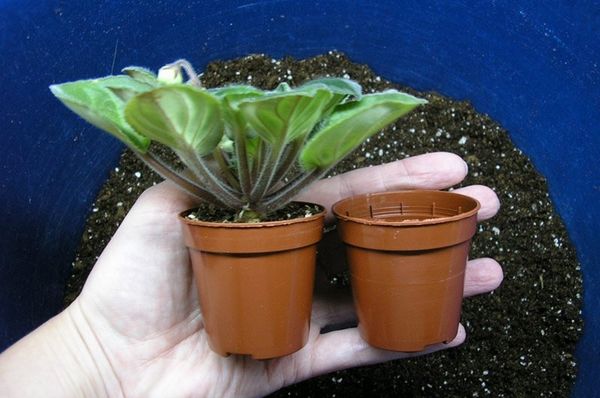
Water the plant immediately after transplanting.
How to trim?
Violets do not need to be pruned regularly. Leaves can be removed only in case of disease or for subsequent reproduction.
The origin and features of the flower
 The flower was first discovered in 1892 in East Africa by Governor and Baron Adelbert Walter von Saint-Paul during a day walk. Noticing an unusual purple flower, he collected the seeds and sent them for research to his father in Germany, who forwarded the package to Hanover to the director of the botanical garden, who examined the plant and named it part of the Gesneriaceae family.
The flower was first discovered in 1892 in East Africa by Governor and Baron Adelbert Walter von Saint-Paul during a day walk. Noticing an unusual purple flower, he collected the seeds and sent them for research to his father in Germany, who forwarded the package to Hanover to the director of the botanical garden, who examined the plant and named it part of the Gesneriaceae family.
In 1893, the plant was already adorned at flower exhibitions and was officially recognized. Since then, the beautiful, tropical flower has spread and has been cultivated as indoor pets in many countries.
External description and photo
Saintpaulia is a perennial tropical herb with beautiful flowers. The root system is poorly developed and has a fibrous type, the stems can be basal or with hanging rosettes. Depending on the variety, the diameter of the rosette varies from 6 to 55 cm.Externally, the flower can be described as follows:
- The leaves are round, fleshy, juicy, veins are clearly visible along the length of the leaf, the edge of the leaf is sharp or rounded. The surface is covered with fine, needle-like fibers. The shade of the leaves is mainly dark green, but there are specimens with a light core (pink, cream, salad), some species have a red tint. The seamy side is light, silvery green. The coating can be smooth, matte or corrugated with raised bumps.
- Stems are brown or dark red, juicy, straight. The bud stems branch up to 15 small, flowered processes.
- The flowers are simple, with five petals and two stamens, collected in a brush. Depending on the variety, the buds are simple and double.
- The seed box is round with the presence of small seeds; under the influence of moisture, it gradually collapses. All about indoor violets can be told by botanists engaged in plant breeding and breeding new varieties every year.
The best varieties of violets: description
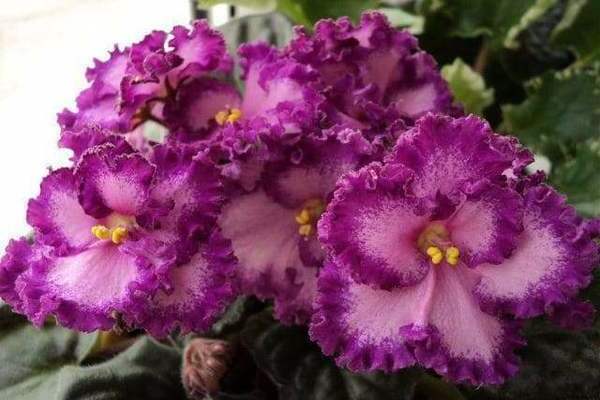
Violets can be very different from each other in size, in the shape of flowers, as well as in many other characteristics - growth rate, abundance of flowering, reaction to certain conditions.
In this article, we will help flower growers understand the complexity of the classification of violet species, talk about the most common, original and unique varieties, about their characteristics and differences from many other cultures.This article will be very rich due to the amount of information, but we will try to structure it to make the grower more interesting.
Saintpaulias, they are also indoor violets, are plants belonging to the order of clear-flowered, the genus Saintpaulia. Due to the fact that these flowers in their appearance really very much resemble a real violet (viola), it is often confused with a violet, and also called it the African violet - in accordance with the area where Saintpaulia was first discovered at the end of the 19th century ... In this article, we will still call the plant a violet, since it will be more convenient to perceive information and immediately form the image of this unusual, but very attractive plant.
Let's talk a little about what varieties of violets and species are distinguished in floriculture today.
In general, the territory of natural distribution of wild Saintpaulias is limited to mountainous areas, mainly Tanzania or Kenya, since in that setting, planting feels most comfortable, it is very easy for them to grow and develop, because the ideal temperature and humidity are.
Also, wild violets are found near river banks, near waterfalls or on ravines for days, in partial shade, which comes from large trees. Violet does not tolerate direct sunlight at all, since under them it simply dies.
If we talk about how many species of Saintpaulias grow today in their natural habitat, then experienced flower growers have about twenty main species. We will just introduce you to some of them in this article.
Velvet violet. She has toothed, rounded, dark green leaves, which reach five centimeters in size, no more. A reddish decorative pattern can be seen on the back of the leaflet. At the same time, the flowering of the variety is very lush. It consists of not very large flowers, which are painted in blue-violet color, and in the middle they have a dark speck that looks quite attractive. And in general, this planting can stand out against the background of many other plants, the main thing is to observe agricultural technology and take care of the variety.
Grotte. This is a plant that belongs to the ampelous subtype of plants. The leaves are rounded, slightly pubescent, painted in a bright green tint. Also, sometimes the leaves can have a bright purple color, the length of the leaf plate is about six centimeters, and the width is five centimeters. The flowers are small, purple, their diameter reaches 2.5 centimeters, in the middle there is a dark eye. In order to somehow balance the composition, you can also notice the same dark border on the petals, so that the flowers look more harmonious in general.
Violet-flowered Saintpaulia (in other words - violet-flowered). This plant is distinguished by the fact that a rosette of rather large dimensions is formed in it. The diameter can be up to sixty centimeters. The stems are juicy, short, have dark green leaves, which are colored dark green.
The length of the leaf is eight centimeters. Further, we will dwell in more detail directly on the varieties of indoor plants, on the classification, since this is a very diverse culture, and flower growers sometimes want to navigate in varietal diversity in order to have a broader understanding of the culture.
Growing Saintpaulias at home
Watering
Don't overdo it when you care for your Saintpaulia. It is better to slightly dry out the earthen lump than to pour it over. Water not before the top layer of the earth dries. Use warm, settled water for irrigation
Watering time is important: Water in the morning in the spring and summer and in the afternoon in the autumn and winter. Water from above using a watering can with a thin, long spout to keep the water out of the leaves
Pour until a little water appears in the pan, then drain it immediately. Watering from below is possible. Pour some water into the pan and wait until the required amount is absorbed, drain the excess.
Lighting
Lighting should be close to natural habitat conditions. Since the violet is found by a stream in the canopy of trees, where there is no direct sunlight, diffused lighting will do. Window sills of the eastern and western orientation will be ideal, because on the southern ones it is necessary to provide shading, and in the northern ones, without additional illumination, the plant will suffer from a lack of lighting. You can use fluorescent lamps and put a violet not only on the windows, but also in the back of the room.
The state of the plant will tell you about the correct lighting: if there is enough light, new leaves will appear and flowering will also be normal. Rotate the flower from time to time to distribute the lighting evenly
Please note that varieties with dark leaves need more light, respectively, varieties with light colored leaves require less light, and may turn yellow from its excess. In general, you need lighting for 12-14 hours a day.
Temperature
Despite the fact that Saintpaulia is from hot Africa, she does not like high temperatures. A comfortable temperature is considered to be about 20 ° C, only for growing "children" a temperature regime of 22-24 ° C is needed.
Growing errors
What to do to keep the flowers from getting smaller?
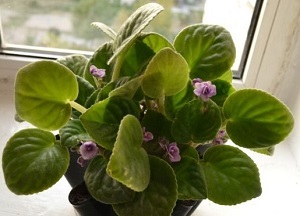 Like any plant, violation of the requirements for care or not creating the necessary conditions leads to the loss of any qualities. The main reasons for chopping flowers are:
Like any plant, violation of the requirements for care or not creating the necessary conditions leads to the loss of any qualities. The main reasons for chopping flowers are:
- first flowering;
- overfeeding with fertilizers;
- heat;
- insufficient humidity in the room;
- soil quality.
Why do the buds start to shrink?
Bud shredding in large-flowered species occurs mainly due to high temperatures, dry indoor air and lack of adequate nutrition.
The root system is unable to provide nutrition to the entire plant due to heavy soil
How does a shortage or excess of substances affect the outlet?
Large, strong show plants need balance - lighting and nutrition. The food should be suitable for the size of the pot. A large crown requires adequate root volume. At the same time, overfeeding causes increased crown growth and a "clumsy" outlet.
Therefore, food should be balanced, brought in "for health", no frills. Malnutrition leads to a delay in growth, development, lack of flowering.
Important! Each plant is individual. Therefore, care should be individualized.
The most unusual violets
It should be noted that this flower can be quite unusual, for which it is very appreciated by flower growers, because you never know what will happen at the exit. The most interesting varieties are the following:
- “Chimera” is a variety obtained by mutation of two plant species. The color of the petals varies from blue to crimson, but there is always a light dividing line in the middle.
- An exotic variety called "Land of Crimson Clouds" has a dark crimson color with an intricate pattern. Violet "Country of Crimson Clouds"
- “Gray ocean” is a flower that has the ability to change color to suit the mood, turned from white to lilac. With each flowering, it becomes darker and darker, and the Gray Ocean variety turns into a Black Pearl.
Violet "Gray Ocean"
There are a lot of varieties of violets, every year breeders try to present something new and unique at exhibitions, so there is no way to mention everything. But each of the varieties is unique and beautiful in its own way.
The article examined the main varieties of indoor violets. This is a beautiful flower that can beautify any space.
For those who are interested in this plant, but have no experience in growing, we recommend starting with mini-violets.
Show varieties are more beautiful, but have a lot of nuances in breeding, which will turn a hobby into exhausting work.
However, regardless of the choice, the interior of the room, decorated with living violets, will be transformed beyond recognition.


